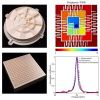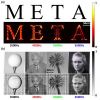Metamaterials and Phononics group

(left) Metasurfaces for the generation of vortices and acoustic holograms. (right) Acoustci pressure and sound absorption coefficient of a 13mm thick absorbing metasurface operating at 50 Hz.

Examples of acoustic holograms generated from predefined images by phase and amplitude modulation across a metasurface

Concept of very wide band acoustic meta-equalizer
Last publications
- Impedance theory-based elastic metasurface enabling precise mode conversion and preservation
Mu Jiang, Hong-Tao Zhou, Tong Zhu, Yan-Feng Wang, Badreddine Assouar, Yue-Sheng Wang
Journal of the Mechanics and Physics of Solids, 2025, 203, pp.106231. ⟨10.1016/j.jmps.2025.106231⟩ - Dual-ring focused acoustic vortices with adjustable intensity and interval via hybrid-degenerated cribriform plates
Xin-Rui Li, Bu-Chen Ping, Da-Jian Wu, Xing-Feng Zhu, Di-Chao Chen, Badreddine Assouar
Physical Review Applied, 2025, 23 (6), pp.064033. ⟨10.1103/trtp-b6cm⟩ - Acoustic Su–Schrieffer–Heeger chain with phase nonreciprocal couplings
Tong Guo, Liyun Cao, Badreddine Assouar, Brice Vincent, Aurélien Merkel
Journal of Applied Physics, 2025, 137 (15), ⟨10.1063/5.0254537⟩
Presentation
The Metamaterials and Phononics group (METAs) develops theoretical, numerical and experimental researches on acoustic and elastic metamaterials and metasurfaces, and more generally on wave propagation in complex media.
METAs research activities are based on 2 main axes:
• Understanding the physical mechanisms involved in metamaterials, metasurfaces and phononic crystals.
• The design and realization of innovative devices and systems capable of manipulating the propagation of acoustic and elastic waves in a highly controlled manner.
The approaches on which the strategy is based are theoretical, numerical and experimental.
The group has had long experience in the field of metamaterials, phononics and their interactions with acoustic, elastic and vibration waves. It has developed many innovative concepts, notably concerning :
• acoustic absorption at very low frequencies
• super-focusing
• acoustic holography
With an intensive numerical calculation platform, fabrication equipment and experimental measurements for acoustics and vibrations, the METAs group tackle on the properties and functionalities of the metamaterials it develops. The group develops experimental approaches to measure the absorption, reflection and transmission of acoustic and elastic waves for the metastructures, and to qualify the performance of the associated devices.
Metamaterials, which are artificial structures with remarkable and unprecedented properties, allow to deal with new physics, to produce new functionalities, and to propose innovative systems and devices that may lead to scientific and technological breakthrough. To this end, the metamaterials group focuses on the development of applications for aeronautical, automotive, environmental, biomedical, and space fields. The group develops, for instance, metamaterials and metasurfaces for very low-frequency sound absorption, acoustic invisibility, illusion, biomedical imaging, holography, acoustic levitation, etc.
On another hand, the METAs group is developing several fruitful national and international collaborations, especially with universities in the USA (Georgia Institute of Technology), China (Tongji University, SCUT-Guangzhou and Tianjin University in particular) and South Korea (Seoul National University). These collaborations take various forms of exchanges and joint projects: PHC, PICS, etc.
Research topics
Metamaterials and acoustic metasurfaces
The group develops numerical models to understand the mechanisms of propagation and interaction of acoustic and elastic waves with complex metastructures. These models are based on classical approaches such as finite elements method, and on artificial intelligence algorithms such as deep-learning and convoluted neural network. In parallel, the group develops theoretical methods based on different formalisms to confront the numerical approaches to theory. Experimental fabrication and characterization of the different metastructures and devices are carried out, using the equipment available in the group.
Different applications are developed:
- acoustic absorption in very low frequency regimes
- energy harvesting
- super-focusing
- holography
- Non-reciprocity
The group is also interested in the multifunctional aspect of its metastructures to integrate different functionalities in the same metamaterial or metasurface.
Projects:
- US Air Force Office of Scientific Research, 2018 – 2022 (AIRCRAFT)
- ICEEL Carnot, 2018-2021 (METACOM)
- Région Grand Est; 2018 – 2021 (METACOUSTICS)
Theses:
- Krupali Donda
- Shiwang Fan
Articles:
- Acoustic Metasurfaces, Nature Reviews Materials 3, (2018) 460., M. B. Assouar, B. Liang, Y. Wu, Y. Li, J-C. Cheng & Y. Jing
- Acoustic metasurface-based perfect absorber with deep subwavelength thickness, Appl. Phys. Lett., 108 (2016) 063502. Y. Li & M. B. Assouar [Highlighted by AIP, Phys.org, ScienceDaily, etc. as most cited paper in 2016 and among most read in 2016 and 2017 and a ESI highly cited paper]
Topological and non-Hermitian metamaterials
The group develops topological metamaterials with propagating modes that are immune to defects (i.e. they are topologically protected). The protection associated with topological effects is strong. For example, waveguiding along interfaces allows the development of robust delay lines or waveguides, and more generally access to wave manipulation is much more efficient way than that offered by current acoustic devices.
Non-Hermitian metamaterials also derive from analogies between quantum mechanics and acoustics. Indeed, the concept of non-Hermiticity can be extended to acoustic structures by means of the spatial modulation of loss and gain within the metamaterial. The group is thus developing elastic and acoustic metamaterials, integrating constituents with balanced gain and loss. In this way, it obtains a multitude of phenomena, paving the way for unusual wave manipulations (PT-symmetry approach). Among others, metamaterials based on the PT-symmetry approach have been developed for applications concerning negative refraction or asymmetric propagation.
Project:
PHC France – Chine (2018-2019)
Thesis:
Sheng Wan (2016 – 2020)
Articles:
- PT-Symmetry for Elastic Negative Refraction, Phys. Rev. Applied 10 (2018) 044071, Z. Hou, H. Ni & M. B. Assouar
- Space-time phononic crystals with anomalous topological edge states, Physical Review Research 1 (3), 033069 (2019), M. Oudich, Y. Deng, M. Tao, Y. Jing
- Ultrasonic nodal chains in topological granular metamaterials, Communications Physics 2 (2019) 154, A. Merkel & J. Christensen
Phononics and vibrations
The group is interested in the manipulation of elastic waves using phononic structures and elastic metamaterials for a wide range of applications. We investigate the dispersion of surface acoustic waves by metasurfaces made up of phononic pillars to give rise to confinement phenomena, Fano type resonance, and the acoustic analogue of electromagnetic induced transparency (EIT). The structure could be adapted to the design of platforms for the observation of quantum phenomena, opto-mechanical couplings or for the detection of biological species with very high sensitivity.
The group is also working on the development of metamaterials in the form of multifunctional plates offering the possibility of suppressing vibrations over a wide range of frequencies, and harvesting acoustic energy. The engineering of these artificial materials is specifically dedicated to aeronautic and aerospace applications. In addition, the team is developing work on phononic crystals and metasurfaces for vibration to deal with super-focusing phenomena for biomedical applications, asymmetric propagation or mechanical isolation at low frequencies.
Theses:
- Liyun Cao (2016-2020)
- Yi Zeng (2019-2023)
- Simin Yuan (2017-2021)
Articles:
- Elastic Metamaterial Insulator for Broadband Low-Frequency Flexural Vibration Shielding, Phys. Rev. Applied, 8 (2017) 054034. J-H. Oh, S. Qi, Y-Y. Kim & M. B. Assouar.
- Rayleigh waves in phononic crystal made of multilayered pillars: confined modes, Fano resonances, and acoustically induced transparency, Physical Review Applied 9, 034013 (2018)., M. Oudich, B Djafari-Rouhani, B Bonello, Y Pennec, et. al.
- Acoustic superfocusing by solid phononic crystals, Applied Physics Letters, 105 (2014) 233506. X. Zhou, M. B. Assouar & M. Oudich
Know-how
Numerical modelling and theoretical approaches
- Development of numerical models (1D, 2D and 3D) based on finite elements, Plane Wave Expansion or FDTD
- Development of artificial intelligence algorithms based on deep-learning and convoluted neural network
- Development of theoretical approaches based on effective medium theory, lumped electrical models and multi-physics models
Manufacturing and measurements
- Fabrication of metamaterials by additive manufacturing
- Measurement and characterization of the acoustic and vibration wave field (1D, 2D and 3D). Reflection and transmission measurements
- Scanning Doppler Laser Vibrometry (SLDV) for the frequency range from a few hundred Hz to 50kHz
- Double acoustic impedance tube for transmission, reflection and absorption measurements
- Elastic wave generation and measurement system for the ultrasonic range
Numerical calculation
- 3 numerical super-calculator stations (512 GB memory) equipped with finite element-based simulation software allow the modelling of all designs, particularly complex and 3D ones, of conceived metamaterials and metasurfaces
Members
CNRS researchers
Professors, assistant professors
- Julio Andrés IGLESIAS MARTINEZ
- Aurélien MERKEL
- Mourad OUDICH
- Brice VINCENT
Post-doctoral researchers
- Anis MADDI
PhD students
- Marie Chancia AMOUNGONE
- Ghita BEN AMAR
- Nicolas CAYUELA
- Yuhan HUI
- Mu JIANG
- Jessica MONALDI
- Haobo QI
Publications
Contact
Head of the group
Badreddine ASSOUAR
badreddine.assouar@univ-lorraine.fr
+33 (0) 3 72 74 25 22
+33 (0) 6 76 587 88 93
Nancy-Artem
Institut Jean Lamour
Campus Artem
2 allée André Guinier - BP 50840
54011 NANCY Cedex
